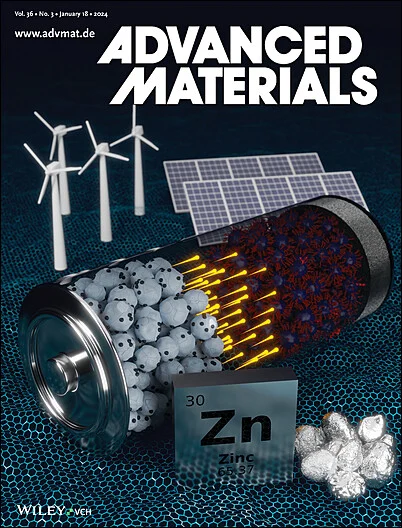cu6sn5型高熵金属间化合物的富氢高效硝酸还原反应
IF 27.4
1区 材料科学
Q1 CHEMISTRY, MULTIDISCIPLINARY
引用次数: 0
摘要
电催化硝酸还原反应(NO3RR)为绿色制氨和废水中硝酸盐污染的治理提供了可行的策略。活性氢(H*)的生成对提高氨产物的选择性、产率和法拉第效率起着重要作用。本文证明了结构有序的纳米多孔cu6sn5型高熵金属间化合物(HEI)对NO3RR具有极其优越的性能。最佳纳米孔(Cu0.25Ni0.25Fe0.25Co0.25)6Sn5 HEI具有97.09±1.15%的NH3法拉第效率和120 h的优异稳定性,在工业级电流密度为1 a cm−2的情况下,可将NO3 -直接转化为高纯度(NH4)2HPO4,效率接近统一。理论计算结合实验结果表明,纳米多孔HEI具有有序的多位点特性,可以同时促进水解离,降低加氢过程的无反应能,抑制析氢。这项工作为可持续NH3合成提供了无贵金属HEI的设计,并为H*富集机制的研究奠定了基础。本文章由计算机程序翻译,如有差异,请以英文原文为准。

Active Hydrogen Enrichment on Cu6Sn5-type High Entropy Intermetallics for Efficient Nitrate Reduction Reaction
Electrocatalytic nitrate reduction reaction (NO3RR) provides a feasible strategy for green ammonia production and the treatment of nitrate pollution in wastewater. The generation of active hydrogen (H*) plays an important role in improving the selectivity, yield rate, and Faradaic efficiency of ammonia products. Here, structurally ordered nanoporous Cu6Sn5-type high entropy intermetallics (HEI) with extremely superior performance toward NO3RR is demonstrated. The optimal nanoporous (Cu0.25Ni0.25Fe0.25Co0.25)6Sn5 HEI delivers a high NH3 Faradaic efficiency of 97.09 ± 1.15% and excellent stability of 120 h at the industrial level current density of 1 A cm−2, accordingly directly converting NO3‒ to high-purity (NH4)2HPO4 with near-unity efficiency. Theoretical calculations combined with experimental results reveal that the ordered multi-site nature of the nanoporous HEI can simultaneously promote water dissociation, reduce the reaction-free energy of the hydrogenation process, and suppress hydrogen evolution. This work provides the design of the precious-metal-free HEI for sustainable NH3 synthesis and paves insights into the H* enrichment mechanism.
求助全文
通过发布文献求助,成功后即可免费获取论文全文。
去求助
来源期刊

Advanced Materials
工程技术-材料科学:综合
CiteScore
43.00
自引率
4.10%
发文量
2182
审稿时长
2 months
期刊介绍:
Advanced Materials, one of the world's most prestigious journals and the foundation of the Advanced portfolio, is the home of choice for best-in-class materials science for more than 30 years. Following this fast-growing and interdisciplinary field, we are considering and publishing the most important discoveries on any and all materials from materials scientists, chemists, physicists, engineers as well as health and life scientists and bringing you the latest results and trends in modern materials-related research every week.
 求助内容:
求助内容: 应助结果提醒方式:
应助结果提醒方式:


